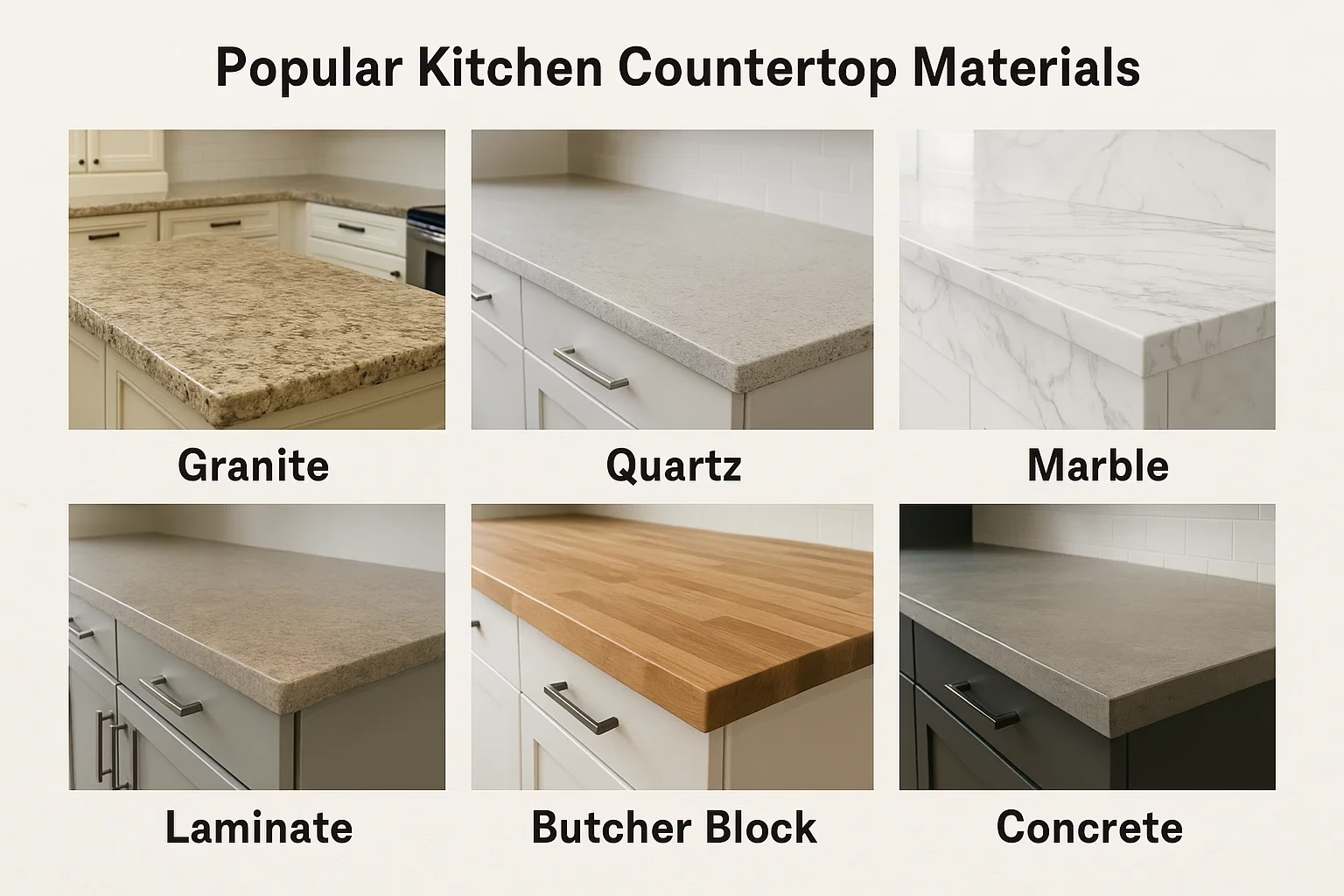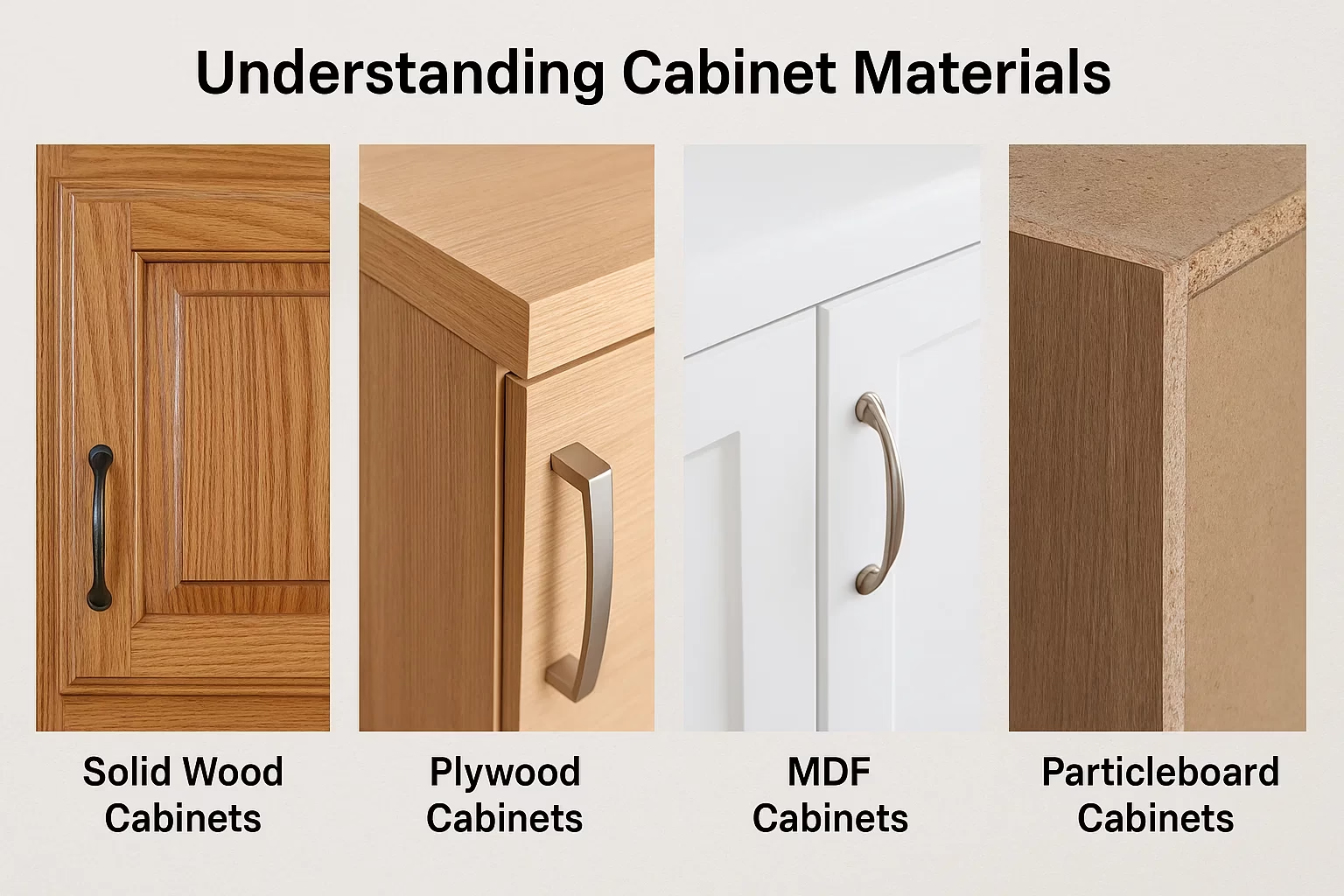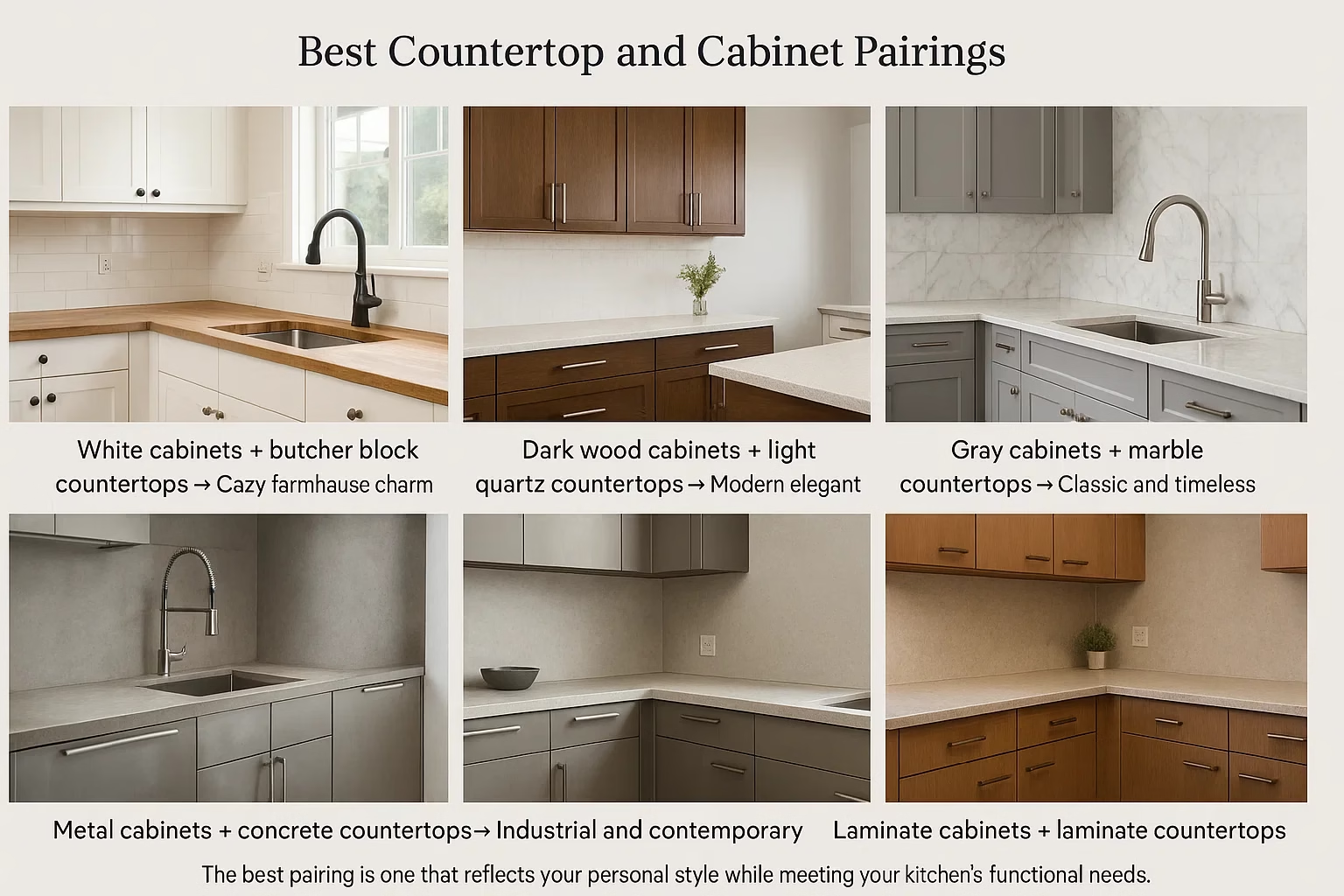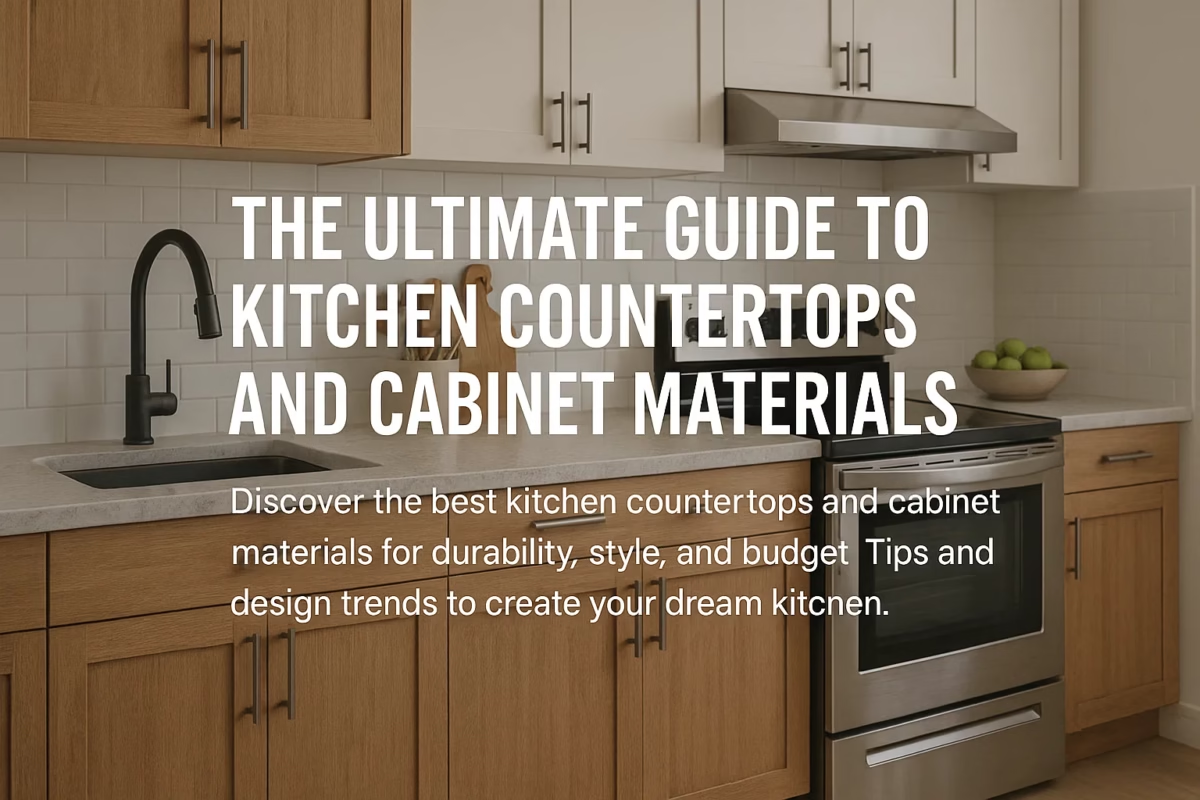Interior Design
The Ultimate Guide to Kitchen Countertops and Cabinet Materials
Kitchen countertops and cabinets form the heart of the home, that is, a functional and stylish kitchen. The kitchen is where families gather, meals are prepared, and memories are made. These two features not only define the look of the space but also determine how practical and enjoyable your kitchen will be to use.
Popular Kitchen Countertop Materials
When planning a kitchen upgrade, the countertop is often one of the first decisions homeowners face. With so many options on the market, it can be overwhelming to choose. Each material comes with its own strengths, weaknesses, and aesthetic appeal. Let’s break down the most popular countertop choices.

Granite Countertops
Granite has long been a favorite among homeowners because of its durability and natural beauty. This natural stone is formed deep within the earth, giving each slab unique veining and color variations. No two granite countertops are ever exactly the same, making them a one-of-a-kind addition to your kitchen.
One of the biggest advantages of granite is its resistance to heat and scratches. You can place hot pots and pans directly on the surface without worrying about damage, and it’s tough enough to handle the occasional knife slip. With proper sealing, granite is also stain-resistant, which is essential in a busy kitchen.
From an aesthetic standpoint, granite offers a wide variety of colors, from soft beiges and whites to dramatic blacks and greens. This versatility means it can complement almost any cabinet material, whether you’re going for a modern, traditional, or rustic look. While granite does require occasional resealing to maintain its non-porous surface, many homeowners consider it a small price to pay for such an elegant, durable option.
Quartz Countertops
Quartz has quickly risen in popularity as a top choice for countertops. Unlike natural stone, quartz is engineered. It is made from crushed quartz stone mixed with resins and pigments. This process results in a non-porous, highly durable surface that requires little to no maintenance compared to natural options like granite or marble.
What makes quartz especially appealing is its wide range of colors and patterns. Because it’s manufactured, quartz can mimic the look of natural stone or offer completely unique designs that don’t exist in nature. From solid colors to veining that resembles marble, quartz gives homeowners endless design flexibility.
Functionally, quartz is resistant to stains, scratches, and bacteria growth. You don’t have to worry about sealing it like granite or marble, making it one of the most low-maintenance choices available. Its consistency in appearance also appeals to those who prefer a clean, uniform look rather than the natural variation of stone.
Quartz pairs beautifully with many cabinet materials, from sleek high-gloss finishes to classic wood. Its adaptability and practicality make it a top contender for anyone seeking both style and durability in their kitchen.
Marble Countertops
If you’re dreaming of a kitchen that radiates timeless beauty and elegance, marble countertops are often the first material that comes to mind. Known for their stunning veining and smooth, cool surface, marble has been a staple in luxury homes and high-end kitchens for centuries. Walking into a kitchen with marble countertops instantly creates an air of sophistication and class that few other materials can match.
From a functional standpoint, marble is ideal for bakers. The naturally cool surface is perfect for rolling out dough, tempering chocolate, and other culinary tasks that benefit from a consistent, chilled worktop. However, marble is softer than granite or quartz, which means it’s more prone to scratches, chips, and etching from acidic foods like lemon juice, wine, or tomato sauce. Because of this, it requires careful handling and regular sealing to maintain its beauty.
When it comes to aesthetics, marble offers unmatched natural patterns. Each slab is unique, with distinctive veins that can vary dramatically in color and intensity. Homeowners often see these veins as works of art. White marble with gray veining is the most iconic, but options like green, black, and pink marble are also available for those looking to make a bold statement.
While marble does come with higher maintenance requirements and a steeper price tag, many homeowners view it as an investment in luxury. Paired with elegant cabinet materials such as solid wood or high-gloss finishes, marble creates a truly show-stopping kitchen design.
Laminate Countertops
Laminate has been around for decades and has undergone significant improvements in both appearance and durability. Modern laminate options mimic the look of natural stone, wood, or even quartz, giving you a stylish kitchen at a fraction of the cost.
One of the biggest benefits of laminate is its affordability. It’s one of the most budget-friendly countertop materials available, making it ideal for first-time homeowners, rental properties, or those doing a kitchen renovation on a tight budget. Beyond cost, laminate is also lightweight and easy to install, which can help cut down on labor expenses.
In terms of versatility, laminate comes in an incredible range of colors, patterns, and finishes. Whether you want a sleek, modern look or a warm, classic feel, there’s a laminate design that can complement your chosen cabinet materials. For example, a woodgrain laminate can pair beautifully with painted cabinets for a rustic farmhouse vibe, while a marble-look laminate can mimic luxury at a lower price point.
The trade-off with laminate is durability. While it resists stains and is easy to clean, it can scratch, chip, or peel over time, especially when exposed to moisture at the seams. Hot pans can also damage the surface, so homeowners need to use trivets or heat pads. Despite these drawbacks, laminate remains a popular choice because it allows for frequent style updates without breaking the bank.
Butcher Block Countertops
If you want to bring warmth and character into your kitchen, butcher block countertops are a fantastic option. Made from strips of hardwood, often maple, oak, or walnut, that are glued together, butcher block offers a cozy, rustic charm that instantly makes a kitchen feel inviting. It’s especially popular in farmhouse-style or cottage-inspired kitchens, but it can also blend beautifully into modern designs when paired with sleek cabinetry.
One of the unique advantages of butcher block is its ability to double as a functional workspace. Unlike stone or laminate, you can safely cut and chop directly on the surface (though this will leave marks). Many homeowners embrace these marks as part of the countertop’s evolving character, but if you prefer a smoother look, regular sanding and refinishing can restore its original beauty. Over time, butcher block develops a rich patina, adding to its charm and making it even more attractive.
From a maintenance perspective, butcher block requires regular oiling to keep the wood from drying out and cracking. It’s also more vulnerable to water damage and stains, so spills should be wiped up quickly. With proper care, though, these countertops can last for decades and only become more beautiful as they age.
When paired with white cabinets, butcher block creates a bright and airy farmhouse look, while darker wood tones can complement rich, bold cabinetry for a more dramatic effect. Its natural warmth makes it one of the best countertop choices for creating a cozy, welcoming atmosphere in your kitchen.
Concrete Countertops
For homeowners who want something unique and ultra-modern, concrete countertops are an exciting option. Unlike natural stone or laminate, concrete countertops are fully customizable. They can be poured and molded to fit any kitchen layout, allowing for creative shapes, textures, and finishes that aren’t possible with other materials.
Concrete countertops can be polished to a sleek, glossy finish or left with a matte, industrial look, depending on your style preference. They can also be tinted with different colors, embedded with stones or glass for texture, or even imprinted with designs. This makes them an ideal choice for homeowners who want a truly personalized kitchen centerpiece.
Durability is one of concrete’s strong suits, but like natural stone, it does require sealing to prevent stains and cracks. Without proper care, it can develop hairline cracks over time due to natural shifting or temperature changes. That said, many homeowners actually find these imperfections add to the material’s industrial charm.
Concrete pairs particularly well with modern cabinet materials like metal or sleek laminates, but it can also create a striking contrast when combined with traditional wood cabinets. The ability to fully customize makes it one of the most versatile and design-forward countertop options available today.
Understanding Cabinet Materials
While countertops often get the spotlight, cabinets are the backbone of every kitchen. They provide structure, storage, and set the tone for your overall design. Choosing the right cabinet material isn’t just about appearance. It’s also about durability, cost, and maintenance. Let’s explore the most common cabinet materials and what makes each one unique.

Solid Wood Cabinets
When you think of traditional, high-quality cabinetry, solid wood probably comes to mind. Solid wood cabinets have been used for centuries, and they’re still one of the most popular choices today. Woods like oak, maple, cherry, hickory, and walnut are prized for their strength and natural beauty. Each type of wood has its own grain patterns and tones, which means you can achieve a wide variety of looks.
The beauty of solid wood lies in its natural variation and timeless appeal. Over time, wood can develop a rich patina that adds even more character to your kitchen. It’s also durable enough to withstand years of use, and if it does get scratched or dented, it can usually be sanded down and refinished, giving your cabinets a second life.
However, solid wood isn’t without its drawbacks. It tends to expand and contract with humidity, which can sometimes cause warping or cracking if the wood isn’t properly treated. It’s also on the more expensive side, especially when using premium hardwoods. But for homeowners who want long-lasting beauty and strength, solid wood cabinets are often worth the investment.
Plywood Cabinets
Plywood is a strong, engineered wood product made by layering thin sheets of wood veneer and gluing them together. Because the layers are placed at alternating angles, plywood is resistant to warping and provides excellent structural integrity. This makes it a great choice for cabinet boxes, shelves, and doors.
Compared to solid wood, plywood is typically more affordable but still offers impressive durability. It can handle the weight of heavy countertops like granite or quartz without sagging, which is essential for long-term use. High-quality plywood also holds screws and hardware securely, reducing the risk of doors coming loose over time.
From a design perspective, plywood is often used with a wood veneer or laminate finish, allowing you to achieve the look of more expensive wood at a lower cost. It’s also lighter than solid wood, which makes it easier to install and move around during renovations.
Overall, plywood strikes a balance between affordability, strength, and versatility, making it one of the most common materials for kitchen cabinets today.
MDF Cabinets
Medium-Density Fiberboard (MDF) is another engineered material that has become increasingly popular in modern kitchens. Made by compressing wood fibers with resin under high pressure, MDF creates a smooth, uniform surface that’s ideal for painted finishes.
One of MDF’s standout advantages is its ability to hold paint beautifully. Unlike solid wood, which can show knots and grain patterns, MDF provides a flawless, even finish. This makes it a favorite choice for sleek, modern cabinets in bold colors or classic white.
MDF is also relatively affordable compared to solid wood or even high-quality plywood. However, it’s not as strong, and it can be vulnerable to water damage if not properly sealed. This means it’s best suited for areas that won’t be exposed to excessive moisture, such as upper cabinets or decorative panels.
Despite these limitations, MDF offers a great balance of style and cost, especially for homeowners who want a modern, smooth cabinet design without breaking the bank.
Particleboard Cabinets
At the lowest end of the price spectrum, you’ll find particleboard cabinets. Made from compressed wood chips and sawdust bonded with resin, particleboard is lightweight and very budget-friendly. Many ready-to-assemble cabinets and flat-pack furniture use this material.
While particleboard offers significant cost savings, it’s also the least durable option. It doesn’t hold screws as well as plywood, and it can swell or deteriorate if exposed to water. However, when covered with a laminate or veneer finish, particleboard can look surprisingly stylish and can be a practical choice for homeowners on a tight budget or for secondary kitchens, like in a basement or rental unit.
Think of particleboard as an entry-level cabinet material. It may not last as long as solid wood or plywood, but it provides a functional, attractive solution at a fraction of the cost.
Metal Cabinets
For those who want a bold, modern, or industrial look, metal cabinets are an exciting option. Stainless steel is the most common choice, often seen in professional kitchens because of its durability and resistance to heat, moisture, and stains. Unlike wood, metal won’t warp or crack, and it’s easy to clean.
Metal cabinets are also incredibly long-lasting. They can withstand years of use without showing much wear, making them a smart investment for homeowners who prioritize function over tradition. They pair especially well with contemporary countertops like quartz, concrete, or stainless steel.
The main drawback? Fingerprints and smudges are very noticeable on metal surfaces, so they require frequent wiping to stay looking polished. They’re also more expensive than particleboard or MDF, but many homeowners see them as a worthwhile investment for their sleek, professional aesthetic.
Choosing the Right Countertop for Your Cabinets
Now that we’ve covered the wide world of countertop and cabinet materials, the next challenge is pairing them together. The right combination will enhance your kitchen’s beauty and functionality, while the wrong one could leave the space feeling mismatched or impractical.
Matching Colors and Textures
When pairing countertops and cabinets, color harmony is crucial. If your cabinets are dark, like espresso or navy blue, a lighter countertop such as white quartz or marble can create a striking contrast. On the flip side, light cabinets can be paired with darker granite or rich butcher block for balance.
Textures matter too. A heavily veined marble or patterned granite might look best with simple, solid-color cabinets to avoid visual clutter. Meanwhile, sleek cabinets in a flat finish can be elevated with a textured countertop like concrete or wood for added depth.
The goal is balance: let one element be the star while the other plays a supporting role.
Balancing Durability and Budget
It’s not just about looks. Functionality and budget play major roles in your decision. For example, pairing expensive solid wood cabinets with high-end marble countertops may look stunning, but it’s also a costly combination that may not fit every budget. On the other hand, combining plywood cabinets with quartz countertops can give you durability and style without breaking the bank.
Always consider your lifestyle. If you cook daily and need something low-maintenance, quartz countertops with plywood or MDF cabinets might be the best balance. For a showpiece kitchen where aesthetics are the priority, marble with solid wood might be worth the investment.
Best Countertop and Cabinet Pairings

Some tried-and-true combinations include:
White cabinets + butcher block countertops → Cozy farmhouse charm.
Dark wood cabinets + light quartz countertops → Modern and elegant.
Gray cabinets + marble countertops → Classic and timeless.
Metal cabinets + concrete countertops → Industrial and contemporary.
Laminate cabinets + laminate countertops → Budget-friendly and versatile.
The best pairing is one that reflects your personal style while meeting your kitchen’s functional needs.
Conclusion
Your kitchen is more than just a place to cook. It’s the centerpiece of your home, where design and functionality come together to create a space you’ll love for years. Choosing the right countertop and cabinet materials is a big part of that journey. From durable quartz and classic granite to elegant marble or rustic butcher block, every countertop tells a story. Likewise, cabinet materials shape the overall character of your kitchen.
The key to success lies in balance: selecting materials that fit your lifestyle, align with your budget, and reflect your personal style. When done right, the combination of countertops and cabinets will not only enhance the beauty of your kitchen but also improve its functionality and value.
If you’re ready to take the next step in creating your dream kitchen, or even planning your entire home, this is where Nyolenju Structures comes in. With expertise in designing house plans tailored to your needs, Nyolenju helps you achieve a space that blends style, comfort, and practicality. Whether you’re starting fresh or renovating, having professional guidance ensures you make choices that stand the test of time.
Looking to design a kitchen that’s as functional as it is beautiful?
Ready to bring your dream home to life with a plan built just for you?
Connect with Nyolenju Structures today and let us design a home that’s perfectly yours.
FAQs
1. What is the most durable kitchen countertop?
Quartz is often considered the most durable because it’s non-porous, scratch-resistant, and requires little maintenance.
2. Which cabinet material is best for humid climates?
Plywood is the best choice for humid environments since it resists warping better than solid wood or MDF.
3. Can I mix two types of countertop materials?
Yes! Many designers recommend combining materials, such as quartz for main countertops and butcher block for an island, to add style and functionality.
4. How long do cabinets typically last?
High-quality cabinets, such as solid wood or plywood, can last 20–50 years with proper care, while MDF and particleboard may need replacing sooner.
5. What is the easiest countertop to maintain?
Laminate and quartz are the easiest to care for since they don’t require sealing and resist stains well.

